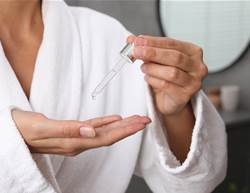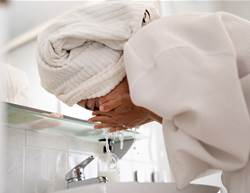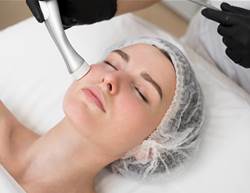Adult acne is frustrating—especially when it shows up around the chin, an area that can often be oily and prone to congestion. If you’re constantly asking how to get rid of chin acne, you’re not alone.
So, what actually causes chin breakouts? “Like other types of acne, chin acne may result from a combination of factors, including increased sebum production, blocked pores, inflammation and bacteria,” says dermatologist Dr Marisa Garshick. “For some people, hormones also play a significant role in driving breakouts around the chin.”
Below, we explore what triggers chin acne, how to treat it, and the dermatologist-approved products that can help you achieve clearer skin—fast.
How to get rid of chin acne fast
While pimple-popping videos are all over the internet, squeezing or picking at breakouts is never a good idea. “It might be tempting, but popping a pimple can increase inflammation and lead to scarring,” says Dr Garshick.
Instead, stick to clinically proven treatments or see a dermatologist. “There’s no one-size-fits-all approach,” says board-certified dermatologist Dr Heather Richmond. “The best results come from personalised treatment plans that evolve over time.”
Retinol
Retinol is a go-to ingredient for treating hormonal acne. It speeds up cell turnover and helps bring deep pimples to the surface so they can heal more quickly. It also helps fade post-acne pigmentation and dark spots.
“Retinol is very effective at keeping pores clear and preventing breakouts,” says Dr Richmond. She adds that adapalene, a type of retinoid, is now available over the counter and is great for mild to moderate acne.
Not sure where to start? Try a 0.25% strength retinol if you have dry or sensitive skin, or 0.5% if your skin is oilier. Stronger formulations may be too drying without a dermatologist’s guidance.
Hydrocolloid patches
When you feel a pimple forming under the skin, hydrocolloid patches can help bring it to a head more quickly. These small, adhesive dots act as a protective barrier and draw out excess oil from the spot. They also stop you from picking, which reduces the risk of scarring.
Look for pimple patches that are discreet, easy to wear, and designed to flatten active spots while preventing bacteria from entering.
Probiotics
If your breakouts are linked to mask-wearing or overall skin imbalance, probiotics may help. Oral probiotics aimed at skin health can support a healthier skin microbiome from within. You can also increase your intake of fermented foods like yoghurt, kimchi, and miso, which help populate the gut and skin with beneficial bacteria.
Some skin-specific probiotic supplements may help calm flare-ups within a few days, though it’s always best to speak with a healthcare professional before starting something new.
Spot treatments
For sudden pimples, spot treatments with active ingredients like benzoyl peroxide or salicylic acid can target inflammation and speed up healing. Choose a product based on your skin type—benzoyl peroxide works well for inflamed pimples, while salicylic acid helps unclog pores and reduce surface oil.
That said, deep or cystic spots may not respond to over-the-counter spot treatments and could require professional care. Overdoing it can also cause irritation or peeling.
Tea tree oil
For a more natural approach, tea tree oil has antibacterial and anti-inflammatory properties that can help calm breakouts. It’s commonly used in gentle cleansers and treatments. A great option is a cleanser formulated with both tea tree oil and salicylic acid, which work together to treat active pimples and prevent new ones.
Natural doesn’t always mean irritation-free, so patch test if your skin is sensitive—and always consult a dermatologist if your breakouts persist.
LED therapy
If you’re after a non-topical option for treating breakouts, light therapy might be your go-to. LED face masks are designed to target acne-causing bacteria on the skin, helping reduce inflammation and prevent future pimples.
Most LED masks offer a range of light settings to address different skin concerns, but if acne is your main issue, opt for blue light. Blue light has been shown to have antimicrobial effects and is often used alongside red light to calm skin and target inflammation.
While it’s not a quick fix for cystic acne, consistent use may support clearer skin over time—especially when used as part of a broader skincare routine.
Visit your dermatologist
If breakouts continue despite home remedies, a visit to your dermatologist may be the next step. Treatments like steroid injections or oral antibiotics can reduce inflammation and ease the discomfort of larger, painful pimples.
Hormonal acne, especially around the chin, can be particularly stubborn. These breakouts often appear in the week before your menstrual cycle, but may start to show up more frequently with age. Unlike surface-level pimples, these deep spots are difficult to treat with over-the-counter options alone.
For recurring hormonal acne, your doctor may recommend prescription medication. A low dose of spironolactone is often used to block excess androgen production that can lead to breakouts. Some people also benefit from oral contraceptives, a contraceptive patch, or a vaginal ring—all of which may help regulate hormone levels.
Your dermatologist might also prescribe a combination of topical treatments, such as benzoyl peroxide with an antibiotic, to use as a targeted spot treatment.
What causes chin acne?
Just like acne on other parts of the face or body, chin breakouts can happen for several reasons. A combination of factors like excess oil production, clogged pores, inflammation and bacteria often play a role. For many, hormones are a key contributor too.
Hormonal chin acne
Hormonal acne doesn’t end with puberty. In fact, it’s especially common in women from their mid-20s through to menopause. Many experience flare-ups in the week before their period, typically due to mild increases in testosterone. These breakouts usually appear on the lower third of the face—mainly the chin and jawline—and tend to be deep, painful and red. Because they form under the skin, they’re tough to pop and slow to heal.
Fungal acne
If the bumps on your chin look more like tiny, inflamed spots without blackheads or whiteheads, you might be dealing with fungal acne. Unlike typical acne, this is caused by an overgrowth of yeast rather than bacteria. Also known as pityrosporum folliculitis or malassezia folliculitis, this type of breakout is actually inflammation of the hair follicles.
Fungal acne often appears as clusters of small, red bumps and can be mistaken for regular acne. It’s more likely to show up after heavy sweating or a round of antibiotics, both of which can disrupt the skin’s natural balance and allow yeast to thrive.
Maskne
Since the COVID-19 pandemic, dermatologists have seen a noticeable rise in breakouts in areas covered by face masks. This condition—often called “maskne”—is caused by trapped breath under the mask, which creates a warm, moist environment and disrupts the skin’s natural microbiome.
In some cases, the issue isn’t just bacteria or moisture—it could be acne mechanica. This type of acne results from friction and pressure on the skin, which can block hair follicles and cause breakouts. It’s the same kind of irritation seen with helmets or chin straps.
Mask-related acne tends to appear as surface-level pimples, including blotchy red bumps, whiteheads and localised irritation around the nose and mouth.
How to prevent chin acne
The simplest step you can take for healthy skin is to wash your face every night. A gentle cleanser followed by a moisturiser is usually enough to support the skin barrier and calm minor breakouts. Choose a face wash that’s formulated for acne-prone skin, especially if you’re dealing with regular pimples.
If you add more products to your routine, be mindful of the ingredients. Avoid anything that clogs pores and stick to oil-free, non-comedogenic options to help reduce flare-ups and support clearer skin.









